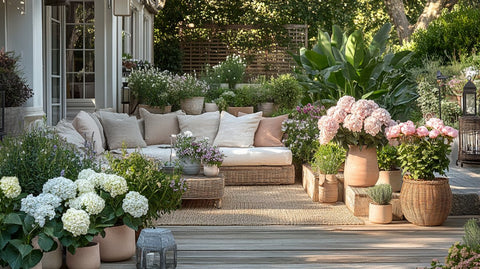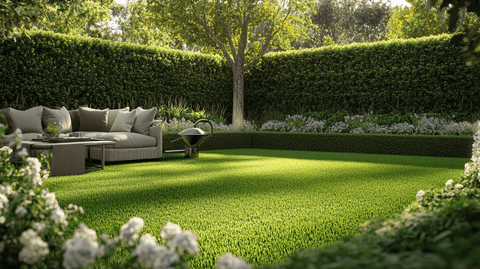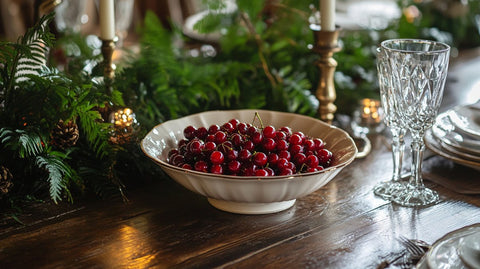Introduction
Gardening success begins with understanding your local environment, and knowing your planting zone is key. Whether you're a novice gardener or a seasoned pro, taking planting zones into account helps ensure that your garden thrives. Imagine nurturing beautiful blooms that flourish with the seasons or maintaining a verdant, lively landscape year-round—this dream is more attainable when you choose the right plants for your planting zone.
Consider the impressive story of a remarkable garden in the heart of New York. Despite the harsh winters, it remains vibrant all year. How? By carefully selecting plants that are well-suited to the region's climate, based on planting zone recommendations. This post aims to guide you in selecting the right plants for your specific planting zones, paving the way for a successful and rewarding gardening experience.
Understanding Planting Zones

A. Definition and Explanation
Planting zones, also known as hardiness zones, are geographically defined areas determined by climatic conditions, especially minimum winter temperatures. These zones indicate where various types of plants can thrive, ensuring they face the least stress from environmental factors.
The United States Department of Agriculture (USDA) Plant Hardiness Zone Map is one of the most widely recognized systems, classifying regions into 13 zones based on a 10-degree Fahrenheit temperature difference between each zone. This zoning helps gardeners understand which plants are suitable for their climate, ensuring optimal growth, flowering, and fruiting conditions.
B. The Role of Temperature in Determining Zones
Temperature plays a crucial role in defining planting zones. Each zone represents the average annual minimum winter temperature of a given region. Within these zones, plants are categorized based on their ability to survive the coldest temperatures expected.
This means if you reside in Zone 7, where temperatures might drop to 0 to 10 degrees Fahrenheit, you'll need to select plants that can withstand such conditions. By aligning your plant choices with your specific zone's temperature range, you enhance the likelihood of successful gardening.
The Importance of Planting Zone Awareness
A. Enhancing Plant Survival Rates
Understanding and adhering to planting zone recommendations is vital to increasing plant survival rates. By selecting plants naturally adapted to your environmental conditions, you're reducing the risk of plant stress or damage from extreme weather conditions. This not only includes temperature but also takes into consideration humidity, wind, and potential frost dates.
B. Promoting Optimal Growth and Aesthetic Appeal
The right plant choice contributes to the aesthetic success of your garden. Plants chosen according to their optimal zones are more likely to reach their full growth potential, offering enhanced beauty, vibrant colors, and healthier foliage. For instance, planting the Adonidia Palm Triple in the right zone yields a striking centerpiece with lush foliage.

Choosing Plants Based on Your Planting Zone
A. Zone 3: Hardy Plants for Harsh Climates
Zone 3 encompasses parts of the northern United States where temperatures can dip to -40 degrees Fahrenheit. Choosing resilient plants like certain varieties of spruce and pine ensures your garden remains vibrant despite frigid winters.
B. Zone 5: Versatile Choices for Moderate Climates
Zone 5 offers a balance, with cold winters and warm summers. A range of bushes, perennials, and hardy trees like maples and firs can flourish here. For added color, consider the Agapanthus Lily of the Nile Blue, which offers stunning blooms in suitable conditions.
C. Zone 7: A Diverse Array of Plant Options
In Zone 7, gardeners enjoy mild winters and hot summers, perfect for a diverse range of plants. The Alexander Palm can thrive here, adding a tropical feel to your garden with its elegant fronds.
D. Zone 9: Warm to Hot Climates and Exotic Flora
Zone 9 allows for growing a wide variety of exotic plants thanks to its warm climate. If you're in Zone 9, consider planting Adonidia Palm Single for a taste of the tropical landscape.
Benefits of Shopping by Planting Zone with Plantology
A. Curated Selection of Zone-Specific Plants
At Plantology, we offer a meticulously curated selection of plants categorized by planting zones. This ensures that you can easily find plants that will thrive in your specific climate, enhancing your chances of gardening success.
B. Expert Guidance and Support
Our experts at Plantology are available to provide guidance and support, ensuring that every plant you choose is well-suited for your zone. Have questions? Reach out to our knowledgeable team for personalized recommendations.
C. Convenience and Quality
Shopping for plants online has never been easier. Plantology provides high-quality plants delivered directly to your door, reducing the hassle of in-person shopping and ensuring a seamless gardening experience. Discover our wide range of products here.

Plantology Featured Products for Different Zones
A. Highlighted Selections for Each Zone
1. Zone 3: Thriving in the Cold
For those in Zone 3, where resilience is a must, evergreen options such as hardy spruces and the versatile Agave Blue stand out as excellent choices for enduring the cold.
2. Zone 5: Embracing Versatility
Zone 5 gardeners can explore options like the lovely Agapanthus, bringing vibrant blossoms to life in your garden landscape. Enhance your garden's charm by exploring our selection of Agave Caribbean Agave Angustifolia.
3. Zone 7: From Palms to Perennials
The diversity in Zone 7 means endless options. From flowers to foliage, plants like the Adonidia Palm Double offer both elegance and durability in this adaptable climate.
4. Zone 9: Exotic Elegance
In Zone 9, embrace the tropical potential with plants that love warmth, like the Aglaonema Silver Bay, known for its stunning pattern and lush leaves.
Conclusion
Understanding and utilizing your planting zone is a dynamic way to ensure gardening excellence, reducing plant loss, and amplifying the beauty of your outdoor space. Take the guesswork out of gardening and embark on a successful gardening journey with Plantology's help. Browse our collection of zone-specific selections today to get started on creating the garden of your dreams.
With the right knowledge and resources, your garden can flourish despite the challenges of your local climate. Visit Plantology to explore a world of plants tailored just for your planting zone.
``` By following this structured format, the content effectively informs readers about the significance of planting zones while integrating Plantology's offerings through informative and relevant content. ```htmlIn the realm of gardening, understanding your planting zone is like holding a key that unlocks the door to successful and sustainable horticulture. By embracing this knowledge, you can craft a garden that not only thrives year-round but also contributes positively to your local ecosystem.
The Science Behind Plant Hardiness

A. Factors Influencing Plant Hardiness
While minimum winter temperature is a primary factor in determining plant hardiness zones, it's important to acknowledge other environmental influences that affect plant growth. These consist of rainfall patterns, soil composition, and sunlight exposure. For instance, plants traditionally suited for Zone 5 will perform best when these additional conditions align favorably, enhancing their resilience and productivity.
Microclimates also play a pivotal role. These are localized climates that can vary significantly from the wider region. They might be created by natural features such as bodies of water, hills, or specific vegetation patterns, and can impact the temperatures within your garden dramatically. Recognizing microclimates within your personal garden space allows for fine-tuning plant placement for optimal growth.
B. The Impact of Soil and Precipitation
The soil type in your area is another essential consideration. Different plants have varying soil requirements—some thrive in sandy soils, while others prefer loamy or clay-rich environments. Conducting soil tests can provide valuable insights into pH levels, nutrient contents, and texture, all of which influence plant health.
Moreover, understanding typical precipitation patterns aids in planning irrigation needs. For example, areas with sporadic rainfall may necessitate drought-resistant plant varieties or efficient watering systems to sustain plant health through dry spells.
Advanced Strategies for Selecting Zone-Specific Plants
A. Leveraging Plant Databases and Tools
Today, digital resources equip gardeners with extensive knowledge databases of plants categorized by hardiness zones, soil preferences, and sunlight requirements. Utilizing these tools can simplify plant selection and maximize garden success. Consider platforms like the USDA Plant Hardiness website or the American Horticultural Society's resources for zone-specific plant recommendations and care tips.
B. Employing Companion Planting Techniques
Companion planting involves growing harmonious plant combinations to naturally enhance growth, improve soil nutrients, or ward off pests. For example, planting marigolds alongside tomatoes can deter nematodes in the soil, serving as a natural form of pest control. This method can be adapted within the constraints of specific zones to bolster plant health and minimize chemical usage.
C. Maximizing Seasonal and Perennial Selections
Balancing annuals, perennials, and biennials enables gardeners to craft dynamic and vibrant landscapes. Annuals can provide immediate color and vibrancy, while perennials offer longevity and consistency year-after-year. In colder climates of Zone 3, hearty perennials such as peonies or irises are worthwhile staples. In contrast, Zone 7's warmer climate supports a more diverse combination, allowing for captivating variations with each season.

Sustainable Gardening Practices for Your Zone
A. Promoting Biodiversity and Native Species
Integrating native plants into your garden supports local wildlife and enhances ecological health. Native plants are naturally adapted to your area's climate, reducing the need for excessive water, fertilizers, or pest controls. Notable examples include the Purple Coneflower (Echinacea purpurea) in Zone 5 or the resilient Yarrow (Achillea millefolium) in Zone 7, both offering benefits to pollinators and resistance to local pest pressures.
B. Adopting Water Conservation Methods
Thoughtful water management is essential to sustainable gardens. Techniques such as rainwater harvesting, drip irrigation, and mulching pathways can drastically reduce water usage while maintaining plant health. These practices are particularly valuable in warmer zones, where irrigation demands are higher. Xeriscaping—a practice focusing on drought-resistant plants—is also an effective strategy for reducing water use in arid areas.
C. Soil Health and Organic Practices
Healthy soil is the foundation of any thriving garden, influencing water retention and nutrient availability. Organic practices like composting, mulching, and using natural fertilizers help maintain soil integrity without harming the environment. Encouraging natural soil fauna, such as earthworms, by avoiding synthetic chemicals is a simple yet effective way of promoting aeration and nutrient cycling in the garden.
Engaging with Local Gardening Communities
A. Joining Gardening Clubs and Networks
Participating in local gardening clubs or community-supported agriculture (CSA) programs connects gardeners to shared resources and knowledge. These networks provide supportive environments where enthusiasts can exchange seeds, share success stories, and collectively address common challenges within the same planting zone.
B. Attending Workshops and Classes
Workshops and classes facilitated by gardening experts offer in-depth insights into advanced horticultural practices and official recommendations. Learning sessions often incorporate hands-on activities, helping participants apply knowledge to real-world gardening scenarios. Engaging with these opportunities keeps gardeners informed of evolving best practices and innovative techniques.
Case Studies of Successful Zone-Based Gardens
A. Zone 3: The Hardy Haven in Minnesota
A remarkable garden in St. Paul, Minnesota, exemplifies adaptive resilience with its selection of cold-tolerant perennials. Despite harsh winters, this garden thrives with the clever use of insulation techniques, strategically positioning windbreaks, and selecting native plants like the resilient Amur Maple and Siberian Iris.

B. Zone 7: Diverse Flora in Tennessee
In Knoxville, Tennessee, a multi-layered landscape flourishes by capitalizing on Zone 7's versatile conditions. With vibrant displays from crape myrtle trees to holly bushes, this garden represents the harmony of flora diversity, supported by carefully executed irrigation and soil management strategies.
C. Zone 9: A Tropical Oasis in Southern California
A Southern California garden transforms dry landscapes into captivating tropical havens. By implementing greywater recycling systems and integrating palm varieties like the Canary Island Date Palm, this garden stands as a testament to sustainable practices in increasingly water-conscious regions.
Conclusion
By embracing the concept of planting zones, gardeners pave the way towards optimized growth, resilient ecosystems, and enduring beauty in their outdoor spaces. Whether utilizing Plantology's expertly curated selections or drawing on a deep understanding of local conditions, your gardening dreams are within reach. Visit Plantology today to embark on a botanical journey fitted perfectly to your zone's unique character.
Remember, awareness is key. With each seed planted in tune with the environmental rhythms of your zone, you’re nurturing not just your garden, but a legacy of sustainable, mindful stewardship for future generations to cherish and enjoy.






























Comments (0)
There are no comments for this article. Be the first one to leave a message!